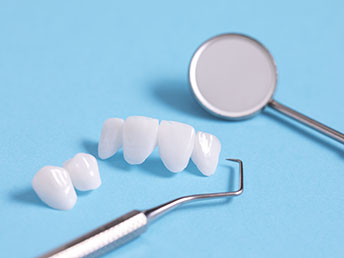Crown & Bridge
What Is A Dental Crown?
A dental crown is used to completely cover a tooth that is damaged. It helps to strengthen the tooth but can also be used to improve its shape, appearance and alignment. Porcelain, a common dental crown material, can be matched to your teeth’s natural color, creating a flawless look. Other crown materials include metal alloys, ceramic and zirconia, and they are usually a better option for back teeth because they are stronger. Dr. Robertson prefers to use zirconium crowns because they are extraordinarily tough, require less tooth removal, and require almost no metal. They are also more natural with a pure white color.
Dental crowns are used to replace large fillings if there is not enough of your original tooth left. They are also used for the following:
- To protect weak teeth from further damage
- To restore a tooth that has been fractured
- As a bridge attachment
- As dental implant covers
- As covers for teeth that are discolored or misshapen
- As covers for teeth that have undergone root canal treatment
What Is A Tooth Bridge?
Bridges are used in situations where teeth are missing. If missing teeth aren’t replaced, the adjacent teeth will eventually shift, which can lead to a bad bite. Missing teeth can also lead to gum disease and TMJ disorders developing.
A bridge fills in the space where teeth are missing. It can be attached either to the adjacent teeth using crowns or using dental implants. In terms of materials, the choice is varied, and it is a decision you will make after consulting with your dentist. The material used will be determined by the position of the missing teeth and will be based on price, function and aesthetics.
How Does A Crown Or Bridge Procedure Work?
A crown and bridge procedure refers to the insertion of a bridge using crowns to fix it in place. The first step is for you to come in for a consultation so we can determine what the best solution for your particular case is.
During the following visit, we will undertake crown and bridge preparation, which involves preparing the abutment teeth—the adjacent teeth which will hold the bridge in place. This means we will reshape the teeth by removing some of the enamel so that we have room to place the crown on top of the teeth.
We will then make an impression of your teeth, which will be used as a guide to make the bridge, crowns and pontic—the false tooth that goes between the crowns. We will make a temporary bridge for you to wear until we can fit in the permanent bridge.
The second session will start with us removing the temporary bridge. We will fit in the new bridge and make the required adjustments to ensure it fits properly. You may have to come back several times to make sure that the bridge fits properly, which means we will use a temporary solution to keep it in place. After a few weeks, once you are happy that it fits well and your bite is comfortable, we will cement the crown or bridge into place.
How to care for your crown & bridge?
It might take a while for you to get used to your new bite, which is why you should stick to eating soft foods until you get used to it. The good news is that a crown and bridge will make eating easier.
In terms of care, you need to keep the rest of your teeth as healthy as possible, which will determine how successful the bridge is. So, this means you need to brush at least twice a day and floss at least one per day. Using an antiseptic mouth wash will also do wonders to keep your teeth healthy.
A crown or bridge can help restore your smile and make life easier because you will find it easier to chew, speak and eat. To find out if you need a crown or a bridge, or both, book an appointment now and let’s get started on restoring the health of your teeth.

